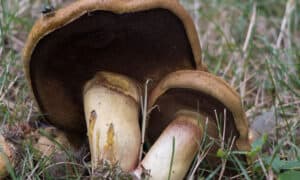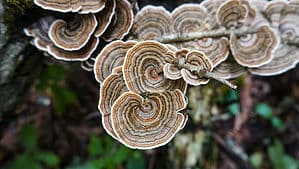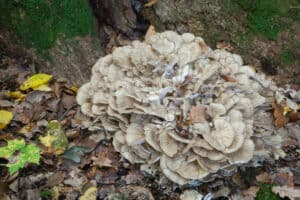If you enjoy cooking, you may be interested in accumulating a list of various commercially produced mushrooms to use in your culinary repertoire.
In this guide, we’ll talk about four commercially cultivated cooking mushrooms that you can use in a variety of delicious dishes! We’ll cover popular culinary uses, cultivation methods, and how they grow in their native environments.
Read on to learn more!
Oyster Mushrooms (Pleurotus spp.)
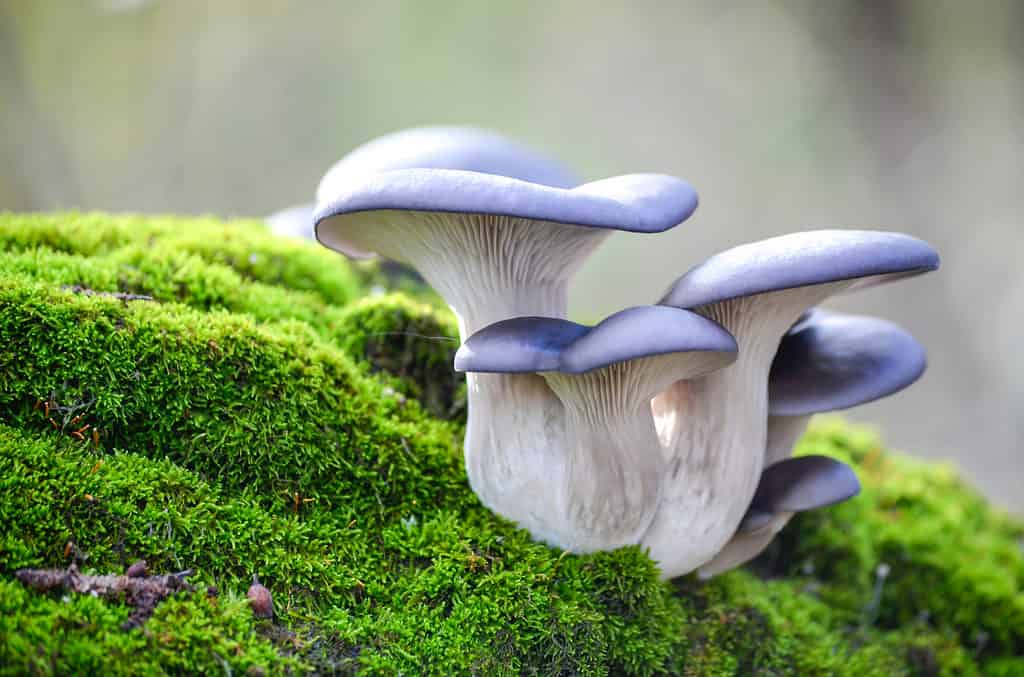
The blue oyster mushroom growing from a mossy stump
©LeManilo/Shutterstock.com
Cultivated and foraged, oyster mushrooms are a widely popular culinary mushroom across the world. These gilled fungi are saprobic, meaning they derive their nutrients from breaking down dead organic matter. In their case, you can usually find oyster mushrooms growing on hardwood logs and stumps. In cultivation, you can readily cultivate the majority of oyster species on a wide range of cellulose-containing substrates, including straw, sawdust, and even cardboard.
Pleurotus ostreatus is known as the common oyster mushroom, growers commercially cultivate it and several varieties of P. ostreatus (such as blue oyster, P. ostreatus var. columbinus) for sale at farmer’s markets, restaurants, and grocery stores. As their common name suggests, the fruiting body caps develop an oyster shell shape. They also taste a bit like seafood. People commonly cook oysters in soups, stews, on the grill, and sautéed. Other species of cultivated oyster mushrooms include Pleurotus djamor (pink oyster), Pleurotus citrinopileatus (yellow oyster), and Pleurotus eryngii (King oyster).
Nutritionally, oyster mushrooms are particularly high in niacin, vitamin B, and antioxidants.
Cooking Mushrooms: Crimini (Agaricus bisporus)
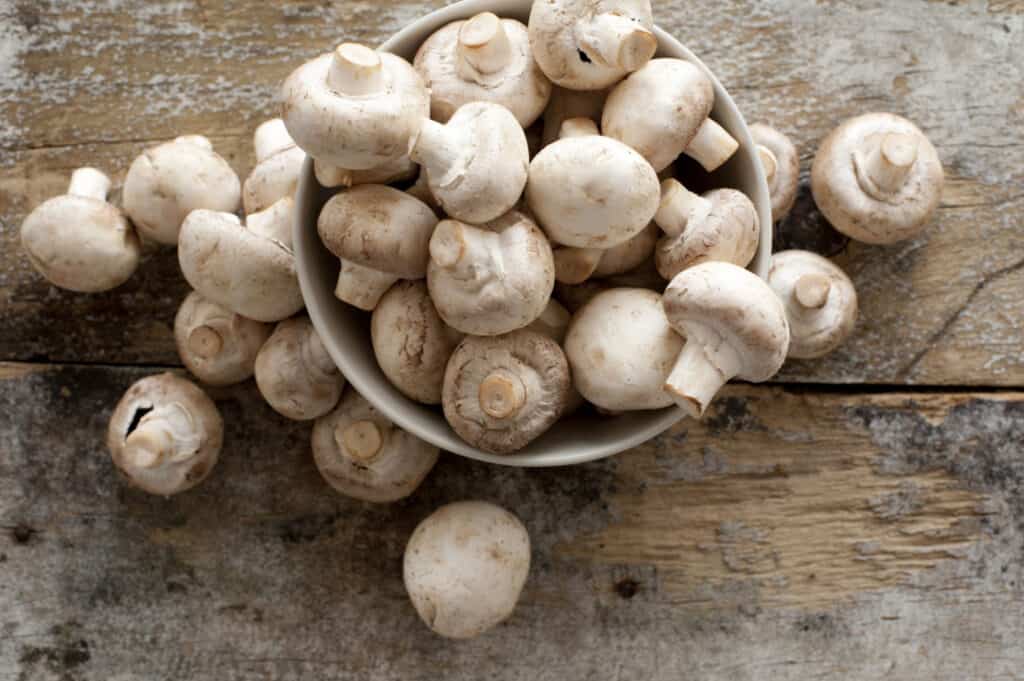
The most common
culinary mushroom
in the U.S. has to be the button mushroom.
©Stephen Gibson/Shutterstock.com
In the US, crimini mushrooms (Agaricus bisporus) are one of the most commonly sold across big box grocery stores. If you order a dish with mushrooms in the US, unless otherwise stated on the menu, you’ll almost certainly get Agaricus bisporus. Brown and white criminis are the immature “button” form of Agaricus bisporus. During their immature phase, the gills are covered by a thin, white, partial veil. When young, they have a fresh, slightly earthy, and mild taste. Their texture is firm, and you can use them in a wide range of dishes. Examples are soups, salads and stir frys, to baked dishes, and grilled entrees.
People typically commercially cultivate these gilled, saprobic mushrooms in pasteurized rows of compost and manure-based substrate. Although rare in the wild, you can find these mushrooms growing in temperate meadow areas. There, they derive nutrients from decaying organic matter such as grass thatch and manure.
Studies have demonstrated that criminis are high in a number of amino acids such as threonine, and essential fatty acids like linoleic acid.
Shiitake Mushrooms (Lentinula edodes)

Shiitake mushrooms cooked in noodle dish
©Julia-Bogdanova/Shutterstock.com
If you’re looking for a culinary mushroom that packs a savory, umami punch of flavor, look no further than shiitake mushrooms (Lentinula edodes). Widely cultivated for sale globally fresh and dried, shiitake mushrooms are well-loved for their bold, umami, nutty flavor, and meaty texture.
They’re particularly popular in East Asia where they grow natively as saprobic fungi on dead hardwood. In the last couple of decades, however, their worldwide popularity has skyrocketed. You can find shiitake mushrooms for sale at both gourmet and several big box grocery stores. People also cultivate them commercially around the world, including in the US.
Shiitakes pack such an amazing concentration of flavor, which actually intensifies when dried. As such, you can use the liquid from rehydrated shiitake as a soup or curry base, or use the powdered form to flavor stir-fries and noodle dishes. These mushrooms are also wonderful for use freshly cooked in various dishes such as Vietnamese noodle soups and Japanese ramen bowls.
In addition to their culinary use, Lentinula edodes provides a nutritionally significant amount of essential fatty acids, antioxidants, and vitamins B1, B2, B12, C, D, and E.
Potential Health Concerns
Of note, heavy metal accumulation of fresh and dried shiitakes mushrooms in some commercial farms has been gaining the attention of health researchers. One study looked at heavy metal accumulation of Lentinula edodes from 27 counties across 14 provinces in China. The results of the study highlighted that the amount of cadmium present in the mushrooms represented mild to moderate pollution risks. The cultivation substrate and production conditions such as water used and the environment of the operation played roles in the presence of heavy metals. If you have concerns about pollution in food, your best bet is to support local farmers with fresh, reputable cultivation methods.
Cooking Mushrooms: Enoki (Flammulina filiformis)

Fresh enoki mushrooms on top of a bowl of tofu and green onion soup
©iStock.com/ma-no
Widely cultivated and consumed in East Asia, enoki mushrooms are also growing in popularity in Western countries, including the US. People use these commercially cultivated mushrooms in a variety of dishes such as rice dishes, ramen bowls, miso soup, salads, and sushi. They are particularly well-suited to being steamed.
Flammulina filiformis is rather unique in that its cultivated and wild forms are remarkably different from each other. Wild Flammulina filiformis tends to produce a light reddish-brown cap and stipe with pale brown gills. The caps of wild enoki are convex and mature to a slightly convex to disc-like shape.
In nature, they are saprobic and grow in clusters on hardwood logs and stumps. In cultivation, enoki looks entirely different. This is due to the low light, low oxygen environments cultivators grow them in. This process produces all-white mushrooms with markedly elongated, thin stems and very small, tightly convex, and almost pin-like caps.
This is another mushroom to keep your eye on in terms of contamination. According to the CDC, more than 20 recalls of enoki mushrooms have been issued since 2020 due to Listeria (a pathogenic bacteria) contamination. As advised by the CDC, you should always thoroughly cook your enoki mushrooms, keep raw enoki separate from other foods, and wash your hands after handling them.
The photo featured at the top of this post is © Slatan/Shutterstock.com
The information presented on or through the Website is made available solely for general informational purposes. We do not warrant the accuracy, completeness, or usefulness of this information. Any reliance you place on such information is strictly at your own risk. We disclaim all liability and responsibility arising from any reliance placed on such materials by you or any other visitor to the Website, or by anyone who may be informed of any of its contents. None of the statements or claims on the Website should be taken as medical advice, health advice, or as confirmation that a plant, fungus, or other item is safe for consumption or will provide any health benefits. Anyone considering the health benefits of particular plant, fungus, or other item should first consult with a doctor or other medical professional. The statements made within this Website have not been evaluated by the Food and Drug Administration. These statements are not intended to diagnose, treat, cure or prevent any disease.
Thank you for reading! Have some feedback for us? Contact the AZ Animals editorial team.



